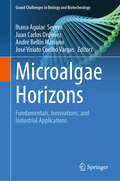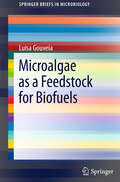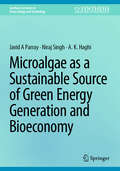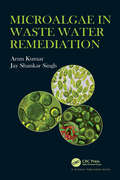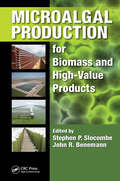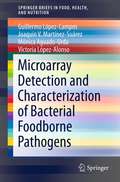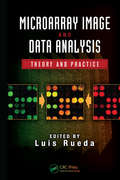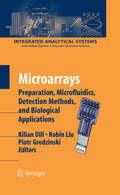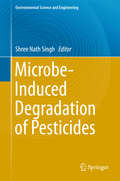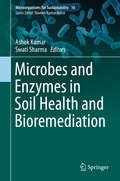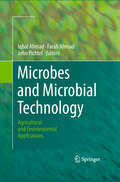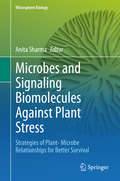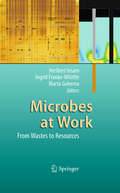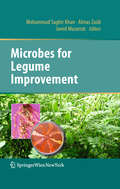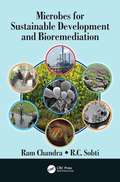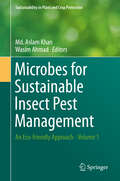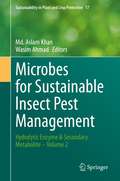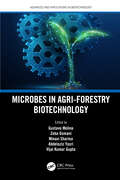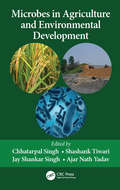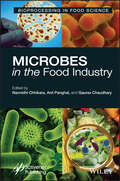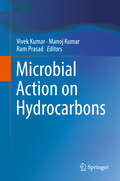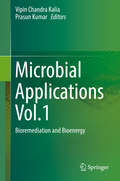- Table View
- List View
Microalgae Horizons: Fundamentals, Innovations, and Industrial Applications (Grand Challenges in Biology and Biotechnology)
by Ihana Aguiar Severo Juan Carlos Ordóñez André Bellin Mariano José Viriato Coelho VargasThis book provides comprehensive recommendations and insights into the fundamentals, innovations, and industrial applications of microalgae-based processes. Covering both upstream and downstream processes, it addresses challenges and solutions in scaling up microalgae technologies from laboratory to industrial uses. Key topics include cultivation techniques, bioreactor designs, harvesting and drying methods, and applications in food, biofuels, and environmental management. Special emphasis is placed on market trends, socio-political factors, regulatory frameworks, innovation, and sustainability, ensuring a holistic understanding of this rapidly evolving field. In addition, the final chapters are dedicated to real-world cases, highlighting pilot projects and large-scale installations that tackle practical challenges in engineering and commercialization. As an interdisciplinary science, microalgae technology has significant relevance in academia, industry, and government, driving innovation and contributing to a growing billion-dollar global market for high-value products. This book serves as an essential resource for students, researchers, scientists, engineers, and professionals seeking to deepen their knowledge and stay updated on the latest developments in microalgae research and applications.
Microalgae as a Feedstock for Biofuels
by Luisa GouveiaThis Brief provides a concise review of the potential use of microalgae for biofuel production. The following topics are highlighted: the advantages of microalgae over conventional biofuel-producing crops; technological processes for energy production using microalgae; microalgal biomass production systems, production rates and costs; algae cultivation strategies and main culture parameters; biomass harvesting technologies and cell disruption; CO2 sequestration; life cycle analysis; and algal biorefinery strategies. The conclusions section discusses the contribution of the technologies described to environmental sustainability and future prospects.
Microalgae as a Sustainable Source of Green Energy Generation and Bioeconomy (Synthesis Lectures on Green Energy and Technology)
by A. K. Haghi Javid A Parray Niraj SinghThe primary focus of the topic is on the production of energy. Here, energy production typically refers to the conversion of waste algal biomass into various forms of usable energy. This could include electricity, biofuels (e.g., biodiesel, bioethanol), biogas, or other forms of renewable energy. Conversion of algal biomass to fuels via extraction of lipids (and potentially other components), through 'algal lipid upgrading' or ALU pathway, combined algal process (CAP) and parallel algal process (PAP). ALU approach based on a biochemical processing strategy to selectively recover and convert select algal biomass components to fuels, namely carbohydrates to ethanol and lipids to a renewable diesel blendstock (RDB) product. The scope of the topic encompasses the various methods and technologies used to convert waste algal biomass into energy. This could involve processes like anaerobic digestion, fermentation, pyrolysis, hydrothermal liquefaction, or other innovative techniques. The topic may touch upon ongoing research, technological advancements, and potential areas of improvement related to waste algal biomass-based energy production.
Microalgae in Waste Water Remediation
by Jay Shankar Singh Arun KumarMicroalgae in Waste Water Remediation aims to point out trends and current topics concerning the use of microalgae in wastewater treatment and to identify potential paths for future research regarding microalgaebased bioremediation. To achieve this goal, the book also assessing and analyzes the topics that attract attention among the scientific community and their evolution through time. This book will be useful to the students, scientists and policy makers concerned with the microalgae mediated management of wastewater effluents and its applications in overall future sustainable development.
Microalgal Production for Biomass and High-Value Products
by Stephen P. Slocombe John R. BenemannMicroalgae are a particularly interesting source of products that range from currently marketed human nutritionals and food ingredients, to potential sources of biofuels and animal feeds. Rapid advances in technology and commercial development are taking place worldwide. Importantly, algal cultivation does not compete with agriculture for land, water, and in some cases, fertilizer resources. Microalgal Production for Biomass and High-Value Products covers the field from a variety of perspectives with 14 chapters contributed by recognized academic experts and industrial practitioners. The book presents the latest technologies and innovations in algal biomass production, from cultivation in open ponds and photobioreactors, to strain selection, synthetic biology, pest control, harvesting, and processing. It explores novel algal products and addresses key issues, including markets, supply chains, business strategies, legal issues, current products, and future prospects. This book brings together the latest advances of interest to those already working in the field while providing an introduction to those beginning to learn about the promise of microalgae as a sustainable source of both specialty and commodity products. It gives stimulating overviews from many different perspectives that describe how laboratory and applied research are creating advances in commercial microalgae production. It also addresses the still many open questions and challenges in this field.
Microarchitecture of Network-on-Chip Routers
by Giorgos Dimitrakopoulos Anastasios Psarras Ioannis SeitanidisThis book provides a unified overview of network-on-chip router micro-architecture, the corresponding design opportunities and challenges, and existing solutions to overcome these challenges. The discussion focuses on the heart of a NoC, the NoC router, and how it interacts with the rest of the system. Coverage includes both basic and advanced design techniques that cover the entire router design space including router organization, flow control, pipelined operation, buffering architectures, as well as allocators' structure and algorithms. Router micro-architectural options are presented in a step-by-step manner beginning from the basic design principles. Even highly sophisticated design alternatives are categorized and broken down to simpler pieces that can be understood easily and analyzed. This book is an invaluable reference for system, architecture, circuit, and EDA researchers and developers, who are interested in understanding the overall picture of NoC routers' architecture, the associated design challenges, and the available solutions.
Microarray Detection and Characterization of Bacterial Foodborne Pathogens
by Mónica Aguado-Urda Guillermo López-Campos Joaquín V. Martínez-Suárez Victoria López-AlonsoThis is a review of recent advances on the use of DNA microarray for diagnosing foodborne pathogens. Rapid detection and characterization of foodborne pathogens is critical for food safety. Many relevant technologies have been intensively developed to date. DNA microarray technology offers a new way to food safety involving pathogen detection and characterization. DNA microarray can be used for detection and characterization of pathogens by analyzing hybridization patterns between capture probes and nucleic acids isolated from food samples or bacteria. It allows more rapid, accurate, and cost-effective detection of pathogens compared with traditional approaches of cultivation or immuno-assays. The application of DNA microarrays to different foodborne bacteria, such as Campylobacter, Salmonella, Listeria monocytogenes, or Shiga toxin producing Escherichia coli, will improve their rapid identification and characterization of their genetic traits (e.g., antimicrobial resistance, virulence). As bacterial foodborne diseases are posing more serious threats to public healthcare, development of rapid and accurate methods for pathogen detection and characterization is critical to their proper control at the earliest time.
Microarray Image and Data Analysis: Theory and Practice (Digital Imaging and Computer Vision #8)
by Luis RuedaMicroarray Image and Data Analysis: Theory and Practice is a compilation of the latest and greatest microarray image and data analysis methods from the multidisciplinary international research community. Delivering a detailed discussion of the biological aspects and applications of microarrays, the book: Describes the key stages of image processing, gridding, segmentation, compression, quantification, and normalization Features cutting-edge approaches to clustering, biclustering, and the reconstruction of regulatory networks Covers different types of microarrays such as DNA, protein, tissue, and low- and high-density oligonucleotide arrays Examines the current state of various microarray technologies, including their availability and affordability Explains how data generated by microarray experiments are analyzed to obtain meaningful biological conclusions An essential reference for academia and industry, Microarray Image and Data Analysis: Theory and Practice provides readers with valuable tools and techniques that extend to a wide range of biological studies and microarray platforms.
Microarrays
by Piotr Grodzinsky Robin Liu Kilian DillCombinatorial chemistry is used to find materials that form sensor microarrays. This book discusses the fundamentals, and then proceeds to the many applications of microarrays, from measuring gene expression (DNA microarrays) to protein-protein interactions, peptide chemistry, carbodhydrate chemistry, electrochemical detection, and microfluidics.
Microbe-Induced Degradation of Pesticides
by Shree Nath SinghThis book focuses on the microbial degradation of endosulfan, lindane, chlorophenols, organochlorine, aldrin, dieldrin, isoproturon and atrazine, etc. which are commonly used in crop fields to kill the pests. Further, it illustrates the role of degradative enzymes, metabolic pathways of degradation, toxicity of metabolites, and the factors regulating the pesticide degradation. In view of persistence of synthetic pesticides, scientists have discovered suitable microbes, such as bacteria, fungi and algae (naturally occurring or genetically engineered) over the years. After successful trials under laboratory and field conditions, these microbes are being used to degrade chemical pesticides in agriculture. As of now 2. 56 billion kg of chemical pesticides is used every year to protect agricultural fields against pest attack. These technologies have been found to be highly effective, eco-friendly and cost-effective without disturbing the agro-ecosystems. As this book contains review articles contributed by various researchers from different countries whose work demonstrates recent advances in microbial degradation of pesticides, it will serve as a ready reckoner and also a valuable quick reference guide for scientists, academicians, cultivators and industrialists alike.
Microbes and Enzymes for Water Treatment and Remediation (Microbial Biotechnology for Food, Health, and the Environment)
by Ashok Kumar Swati Sharma Priya BanerjeeThe introduction of emerging contaminants through anthropogenic activities and industrial discharges has raised significant public health concerns worldwide. Various techniques, including bioremediation, have been explored for their effectiveness in removing pollutants from water bodies and effluents. Microorganisms, particularly bacteria and fungi, have emerged as promising candidates for bioremediation due to their abundance, diversity, and ability to thrive under various conditions. Microbes and Enzymes for Water Treatment and Remediation covers a range of topics, from the role of microorganisms and enzymes in efficient pollutant removal to recent advances in microbial immobilization and enzymatic systems for enhanced wastewater treatment. The book provides up-to-date insights into the potential of microbial and enzyme-based processes for wastewater treatment, addressing challenges and limitations while offering alternative methods for effluent treatment and water reclamation. It serves as a valuable resource for understanding the interplay between microbial, biological, and chemical components in the remediation of toxic aqueous pollutants, aiding both researchers and industrialists in advancing environmental stewardship efforts. Offers comprehensive coverage of emerging contaminants and their impact on public health. Provides in-depth exploration of bioremediation techniques utilizing microbial and enzymatic pathways. Addresses the limitations and challenges of the existing microbial and enzyme-based processes for wastewater treatment.
Microbes and Enzymes in Soil Health and Bioremediation (Microorganisms for Sustainability #16)
by Ashok Kumar Swati SharmaMicrobial enzymes play a vital role in maintaining soil health and removing pollutants from contaminated land. Soil microflora is closely associated with maintaining soil fertility, and the use of chemical pesticides, fertilizers and other volatile sprays in agriculture threatens the health ofthe microbial population in the soil. Every single particle of healthy soil contains millions of bacteria, which interact with the nutrients available, sustaining the nutrient cycle and making this microflora an essential component of life on earth. How do microbes help in the nutrient cycle? Either by intracellular digestion of macromolecules and converting these into smaller units in their metabolic pathways, or by secreting enzymes into the extracellular environment to facilitate the conversion of complex macromolecules into micro-molecules that can be easily absorbed by other living species. To meet demands for energy and food for the growing global population, it is important to protect agricultural land from contamination and maintain its productivity. Heavy metal ions from contaminated land canenter crops, fish or aquatic organismsvia contaminated water, and theseare then taken up by the human body, where they can accumulate and alter the normal microflora.The microbiological component of the soil is ahighly complex system and is still not fully understood. How do microbes survive in the changing physicochemical environment of soil?. This book helps readers understand the mechanism, various routes of microbialsoil remediation, the interactionsof different genera, and how microbial enzymes support the sustainable restoration of healthy soil.
Microbes and Microbial Technology
by Iqbal Ahmad John Pichtel Farah AhmadThis book focuses on successful application of microbial biotechnology in areas such as medicine, agriculture, environment and human health.
Microbes and Signaling Biomolecules Against Plant Stress: Strategies of Plant- Microbe Relationships for Better Survival (Rhizosphere Biology)
by Anita SharmaThis book sheds new light on ways to alleviate biotic and abiotic stress in plants, using signaling molecules of plant growth promotory rhizobacteria. Further, it elaborates on the different types of stress and strategies used by plants under various stress conditions. The respective sections describe the importance of the microbiome for the overall health of plants and how exploring plant-microbe communication and signaling pathways could offer a promising avenue for future research. The book also discusses how rhizobacteria could be exploited in stress alleviation and sustainable agriculture, and addresses omics strategies for stress response and mitigation. Thanks to clearly annotated references, the book also supports and encourages readers to further explore the topics discussed.
Microbes at Work
by Marta Goberna Heribert Insam Ingrid Franke-WhittleAmong the goals of environmentally sound waste treatment is the recycling of organic wastes. The most practiced options are composting and anaerobic digestion, both processes being carried out by microorganisms. This book provides an overview of the various ways microbes are doing their job and gives the reader an impression of their potential. The sixteen chapters of this book summarize the advantages and disadvantages of treatment processes, whether they are aerobic like composting or work without oxygen like anaerobic digestion for biogas (methane) production. These chapters show the potential of microorganisms to create valuable resources from otherwise wasted materials. These resources include profitable organic, humus-like soil conditioners or fertilizer components which are often suppressive to plant diseases. Composts may thus improve soil carbon sequestration, or support sustainable agriculture by reducing the need for mineral fertilizers or pesticides. If anaerobic digestion is used, the biogas produced may replace fossil fuels. Thus, proper biological waste treatment with the help of microorganisms should contribute to a reduction of anthropogenic greenhouse gas production.
Microbes for Legume Improvement
by Javed Musarrat Almas Zaidi Mohammad Saghir KhanMicrobes for Legume Improvement comprises 21 chapters and provides comprehensive information on concepts of microbial technology for the improvement of legumes grown in different agro-ecosystems. The role of microbes including symbiotic nitrogen fixers, asymbiotic nitrogen fixing bacteria (like Azospirillum), plant growth promoting rhizobacteria (PGPR), phosphate-solubilizing microbes, arbuscular mycorrhizal fungi and biocontrol agents in the improvement of both conventional and forage legumes growth is discussed. The role of bacterial biofilms in legume-Rhizobium interactions and metal tolerant microbes in the improvement of legumes is dealt separately. Furthermore, recent findings on the taxonomic status of rhizobia, various signal molecules affecting symbiosis, legume-pathogen and legume-rhizobial interactions and proteomic analysis of legume-microbe interactions are addressed. This volume gives a broad view of legume disease management using microbes and presents strategies for the management of cultivated legumes. It is therefore of special interest to both academics and professionals working in the field of microbiology, soil microbiology, environment microbiology, biotechnology and agronomy as well as plant protection sciences.
Microbes for Natural Food Additives (Microorganisms for Sustainability #38)
by Gunjan Goel Ashok Kumar NaddaThis book provides all the aspects of microbes for food additives, and a detailed description of their different categories. The chapters provide a step-by-step overview of microbial food additives as enzymes, antioxidants, stabilizers, emulsifiers, organic acids, colorants, sweeteners, flavoring compounds that have been used commercially by industrialists. In addition, an emphasis on the use of microbes as therapeutic agents such as probiotics and enzymes have also been given in the respective chapters. Furthermore, the book also comprises the detailed description of legislation and policies for the use of microbial additives at large scale in different food industries. Therefore, this book provides a comprehensive, state of art updated literature which can be used by the food scientists, nutritionists, microbiologists and a health-conscious layman to check the food additive list on a product for a nutritious and safer food.
Microbes for Sustainable Development and Bioremediation
by Ram Chandra R. C. SobtiMicrobes are the predominant form of life on the planet due to their broad range of adaptation and versatile nutritional behavior. The ability of some microbes to inhabit hostile environment incompatible with most forms of life means that their habitat defines the extent of the biosphere and delineates the barrier between the biosphere and geosphere. The direct and indirect role of microbes that include bacteria, fungi, actinomycetes, viruses, mycoplasma, and protozoans are very much important in development of modern human society for food, drugs, textiles, agriculture, and environment. Furthermore, microorganisms and their enzyme system are responsible for the degradation of various organic matters. Microbes for Sustainable Development and Bioremediation emphasizes the role of microbes for sustainable development of ecosystem. Environmental microbiology role in biogeochemical cycle and bioremediation of environmental waste is major theme, which comprises the following aspects: Bacterial phytoextraction mechanism of heavy metals by native hyperaccumulator plants from complex waste-contaminated site for eco-restoration Role of microbial enzyme for eco-friendly recycling of industrial waste Field-scale remediation of crude oil–contaminated desert soil and treatment technology Microbial technology for metal recovery from e-waste printed circuit board Impact of genomic data on sustainability of ecosystem Methane monooxygenases: their regulations and applications Role of microbes in environmental sustainability and food preservation This book will be directly beneficial to researchers and classroom students, in areas of biotechnology, environmental microbiology, molecular biology, and environmental engineering with specialized collection of cutting-edge knowledge.
Microbes for Sustainable Insect Pest Management: An Eco-friendly Approach - Volume 1 (Sustainability in Plant and Crop Protection)
by Md. Aslam Khan Wasim AhmadThis Volume comprises 14 chapters in an attempt to provide the reader with available information on safe and effective use of entomopathogens. Chapters in this book dealing with soil-borne entomopathogens and their phylogeny also provide a review on most updated information of their isolation and molecular identification. Employing fungal pathogens in biological control programmes plays a key role, and conidial thermotolerance and oxidative stress are examined in separate chapters. Entomopathogenic bacteria are able to kill their hosts quickly. An important contribution concerns informations provided upon bacterial cytotoxic factors on insect haemocytes. Nematodes are biological control agents safe to the environment. The information with respect to their direct and indirect effects on non-target organisms is provided. Viruses as highly specific, virulent candidates for use as biological insecticides are safe to non-target species. A separate chapter on the role of granuloviruses in IPM contributes a wealth of information. Biopesticides in combination with synthetic insecticides are reported as effective, economic, and eco-friendly. Understanding their interactions will certainly promote their uses. Finally, emphasis has been given on reviewing synergistic and antagonistic interactions of microbial and chemical pesticides, in other chapters.
Microbes for Sustainable lnsect Pest Management: Hydrolytic Enzyme & Secondary Metabolite – Volume 2 (Sustainability in Plant and Crop Protection #17)
by Md. Aslam Khan Wasim AhmadThe search for new strategies of pest control with safer molecules is currently of great importance and interest. Microbe-mediated biological crop protection is an attractive and promising technology with no concern for a negative impact on the environment and biodiversity. Microbial hydrolytic enzymes such as proteases, chitinases, lipases, etc. are attractive for this purpose. They present toxic properties and act synergistically to control pest attacks. Also, some metabolites, that microorganisms produce for their survival or defense, can be explored and exploited for plant protection. The focus of this Volume is on the potential of microbial hydrolytic enzymes and their metabolites in agroecosystem functioning. Subsequent chapters review topics such as microbial hydrolytic enzymes as powerful management tools, chitinases in IPM of agro-horticultural crops, metabolites as pesticides and the importance of the metabolites of entomopathogenic fungi, metabolites and virulence factors. Other topicas include: microbial-based nanoparticles, recombinant DNA technologies to improve the efficacy of microbial insecticides, the effects of entomopathogens on insect predators and parasitoids, and the management of major vegetable insect pests. This Volume provides detailed accounts on the safe use of microbial products for sustainable management of insect pests. Its aim is to build solid foundations for the students, teachers, and researchers interested in eco-friendly management of important insect crop pests.
Microbes in Agri-Forestry Biotechnology (Advances and Applications in Biotechnology)
by Vijai Kumar Gupta Gustavo Molina Minaxi Sharma Zeba Usmani Abdelaziz YasriThis book explores recent advances on the use of microbes for agri-forestry biotechnological applications. It provides technical concepts and discussions on the use of microorganisms for processes such as bioprocessing, bioremediation, soil enhancement, aquaponics advances, and plant-host symbiosis. The book provides an overview of the microbial approach to the tools and processes used in agriculture and forestry that make or modify products, improve plants for specific uses, and make use of livestock in agricultural systems. The authors discuss the main process conditions that enhance agri-forestry applications with the use of microbes and introduce the use of genetically modified (GM) microbes in agrobiotechnology. Finally, the authors explore the main technological advances in the production of secondary metabolites with potential applications in agri-forestry. This book is intended for biotechnologists, biologists, bioengineers, biochemists, microbiologists, food technologists, enzymologists, and related researchers.
Microbes in Agriculture and Environmental Development
by Chhatarpal Singh, Shashank Tiwari, Jay Shankar Singh and Ajar Nath YadavThe collection of essays in Microbes in Agriculture and Environmental Development explores the applications of microbes for the improvement of environmental quality and agricultural productivity through inoculants and enzymes. These are useful for the conservation and restoration of degraded natural and agricultural ecosystems, crop yield extension, soil health improvement, and other aspects of agriculture and the environment. It discusses the effective use of microbial technology, wastewater treatment, and recycling of agricultural and industrial wastes. It provides detailed accounts of recent trends in microbial application in plant growth promotion, soil fertility, microbial biomass and diversity, and environmental sustainability through bioremediation, biodegradation, and biosorption processes Features: Discusses microbes and their applications for sustainable agriculture and environmental protection in agro-environmental circumstances Presents innovative and eco-friendly approaches for the remediation of contaminated soil and wastewater Focuses on green technologies and sustainability Includes chapters on sustainable agriculture development through increasing soil fertility, physico-chemical properties and soil microbial biomass in nutrient-deprived soils Defines the role of microbial bio formulation-based consortia in the productivity improvement of agricultural crops It will be an invaluable addition to the bookshelves of researchers and graduate students in agriculture and environmental engineering, soil science; microbiology, sustainable agriculture, and ecosystems. Dr. Chhatarpal Singh is presently the President of Agro Environmental Development Society (AEDS), Majhra Ghat, Rampur, Uttar Pradesh, India. Dr. Tiwari is currently working in the field of methanotrophs ecology (methane oxidizing bacteria), which is sole entity responsible for the oxidation of potent greenhouse gas CH4. Dr. Jay Shankar Singh is presently working as a faculty member in the Department of Environmental Microbiology at Babasaheb Bhimrao Ambedkar University in Lucknow, India. Dr. Ajar Nath Yadav is currently serving as an assistant professor in the Department of Biotechnology, Akal College of Agriculture, Eternal University, Baru Sahib, Himachal Pradesh, India.
Microbes in the Food Industry
by Navnidhi ChhikaraMICROBESMICROBES in the Food Industry This newest volume in the groundbreaking new series, “Bioprocessing in Food Science,” focuses on the latest processes, industrial applications, and leading research on microbes in the food industry, for engineers, scientists, students, and other industry professionals. Microbes in the Food Industry, the latest volume in the series, “Bioprocessing in Food Science,” is focused on different aspects in food microbiology, food science and related subjects for individuals in the food industry, researchers, academics, and students. Microbes are key components of the food processing industry, and this book concentrates on topics that incorporate ideas and applications from various fields to address concerns relating to food safety, quality, and sensory attributes. Researchers around the globe will be able to use this information as a guide in establishing the direction of future research on food processing considering various aspects related to microbes. The main objective of this book is to disseminate knowledge about the recent technologies developed in the field of microbiology and their relation to the food industry. Written in an easy-to-understand style, the chapters gathered here are of interest to people in the industry with a great deal of experience and knowledge but also for students and newly hired professionals in the food industry. Whether for the veteran engineer or scientist, the student, or a manager or other technician working in the field, this volume is a must-have for any library.
Microbial Action on Hydrocarbons
by Manoj Kumar Ram Prasad Vivek KumarThe book discusses ways to overcome the side effects of using hydrocarbon-based products as energy sources. Hydrocarbons produce raw crude oil waste of around 600,000 metric tons per annum, with a range of uncertainty of 200,000 metric tons per year. The various chapters in this book focus on approaches to reduce these wastes through the application of potential microbes, in a process called bioremediation. The book is a one-stop reference resource on the methods, mechanisms and application of the bio-composites, in the laboratory and field. Focusing on resolving a very pressing environmental issue, it not only provides details of existing challenges, but also offers deeper insights into the possibility of solving problems using hydrocarbon bioremediation.
Microbial Applications Vol.1
by Vipin Chandra Kalia Prasun KumarThis contributed volume sheds new light on waste management and the production of biofuels. The authors share insights into microbial applications to meet the challenges of environmental pollution and the ever- growing need for renewable energy. They also explain how healthy and balanced ecosystems can be created and maintained using strategies ranging from oil biodegration and detoxification of azo dyes to biofouling. In addition, the book illustrates how the metabolic abilities of microorganisms can be used in microbial fuel-cell technologies or for the production of biohydrogen. It inspires young researchers and experienced scientists in the field of microbiology to explore the application of green biotechnology for bioremediation and the production of energy, which will be one of the central topics for future generations.
